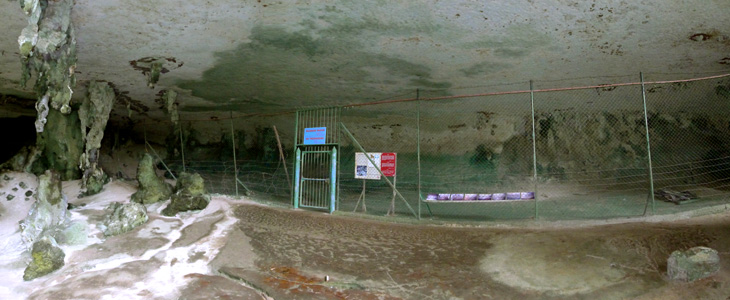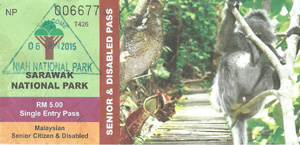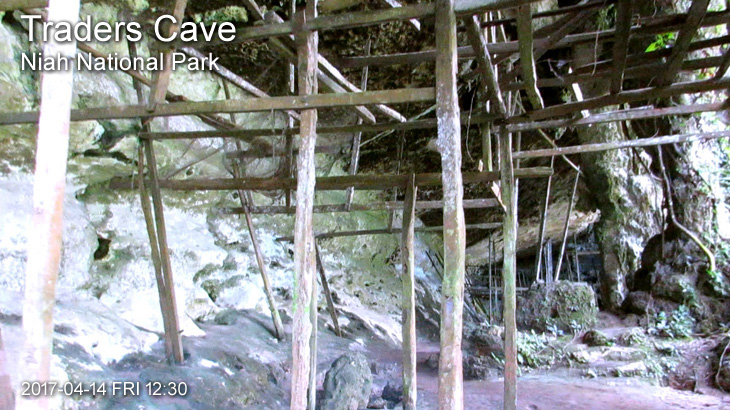
Niah National Park
from Batu Niah Bazaar
HOME > SARAWAK > MIRI DIVISION > Niah National Park
| ENGLISH VERSION | CHINESE VERSION |

Niah National Park
from Batu Niah Bazaar
There are many caves in Niah National Park, tourists only explore the three main caves:
1- Traders Cave
2- Great Cave
3- Painted Cave
Shortly after the Moon Cave, the plank walk emerges into daylight and a short pathway through the forest leads to the Painted Cave. This is the site where the famous Niah Cave paintings and the 'death-ships' were found. The contents of the death-ships have since been transferred to the Sarawak Museum, but the cave paintings and some of the empty death-ships can still be viewed on the wall behind the fenced-off burial site.
The paintings can be difficult to see unless you allow your eyes to become accustomed to the light. They are rendered in red hematite and cover a long narrow strip (approximately 30m) at the back of the cave wall. They portray spread-eagled human figures, probably representing warriors and hunters, some of the animals of the surrounding forest, and - most importantly longboats carrying the souls of the deceased on the dangerous journey to the land of the dead.

"The Longboat to Heaven" Painted Cave, Niah National Park.

"The Two Jumpers" Painted Cave, Niah National Park.

"Drowning In The Sea" in Painted Cave, Niah National Park.

"Big Sea Monster" Painted Cave in Niah National Park.

Above images from photos displayed at the Painted Cave.

"Dancing Angel in Heaven" and "Arriving Heaven" in Painted Cave,
Niah National Park.

Close up view of "Dancing Angle in Heaven" and "Arriving Heaven"
in Painted Cave, Niah Park.

"Dancing Angle in Heaven"
Painted 2,000 years ago in Painted Cave of Niah National
Park, Borneo Island.

Niah Cave paintings are fenced-off to
protect the paintings.
Niah National Park has a number of chalets and hostels for visitors to stay over night.
These accommodation available here can be booked from the visitorís info centre in Miri.
The alternative is you can use one of three Hotels in Batu Niah Town 3 Km away.
A guide is not essential as the trail is clear but they are not expensive and will give you some additional information.

Sample receipt for room in Forest Lodge Type 7 (Hostel)
|
Room/unit 085-737450 or 085-737454 |
Facilities |
Rate per night per room |
| Forest lodge type 2 ( VIP chalet) | 3 rooms |
Rm 250.00 |
| Forest lodge type 4 (Class 2 chalet) | 2 rooms, 4 beds & air-con |
Rm 157.50 |
| Forest lodge type 4 ( Class 3 chalet) | 2 rooms, 4 beds & fan |
Rm 105.00 |
| Forest lodge type 7 (Hostel) | 4 rooms with 4 single beds |
Rm 40.00 |


Entry Pass for Niah National Park for Senior Citizen and
Adult
Entry Fees/Admission Fees
A nominal entry fee for all National Parks in Sarawak.
Entrance fee is RM10 for adult and RM5 for child. RM5 for Senior Citizen & Disabled.
Entrance fees are paid upon arrival at the park HQ. Remember to get a trail map of the park at the counter.
A permit is required for professional photography or filming, which should be arranged in advance with the National Parks Booking Office in Miri.

Wooden remains of huts used by nest collectors till 1970s.
Traders Cave at Niah National Park
The Traderís Cave
The first significant rock formation you reach is called the Trader's Cave, which is really an extended rock overhang rather than a cave proper. This is where the birds nest and guano traders traditionally conduct their business, hence the name. A few minutes later, the West Mouth of the Great Cave comes into view, and you are left in no doubt that this cave deserves its name.
|
Express buses terminal in Bintulu City: Terminal Bus Bintulu |
Rest
and stop in Batu Niah Junction: Batu Niah Junction |
Express buses terminal in Pujut, Miri City: Terminal Bus Pujut, Miri |
 |
 |
 |
TRANSPORT
There is no taxi stand at the Niah Park non any minivan service available.
You can request the park office to call a taxi from the main road junction to come to the park to pick you. But that fare may cost a bit higher.
If you are unable to get any transport out of the park, try this private taxi : Mobil Phone 017-8082008. The driver is a Chinese who speak English. He might be an old man today, but when he was young he and his adventurous young peer group ventured deep into the Niah caves. He has interesting stories to tell such as unnamed caves with ancient "Jar Coffins". These caves have never visited by travelers and tourists.
Private taxi from Niah Town to the park is Rm 10.00. This is the same with from the Niah Junction to the park also Rm 10.00.
RELATED TOPICS
| Sarawak |